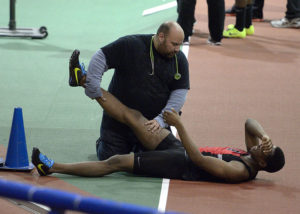
When pushed to extremes, the human body can break, and the Olympics is as extreme an environment as most athletes will ever face. Some of the most common injuries are fractures and stress fractures, hazards that also plague the rest of us. However, when quickly addressed and properly managed, many injuries can heal, and most athletes can return to their sports.
Several of the injuries at the 2016 Summer Olympics in Rio de Janeiro were intense. Andranik Karapetyan, a twenty year old Armenian weightlifter and a favorite to medal, disturbingly dislocated his elbow while attempting to lift 195kg (429 lbs). Samir Aït Saïd, a twenty six year old French gymnast, experienced a similarly graphic injury when he broke his leg during qualification.
In all, quite a few injuries were recorded for the 2016 Summer Olympic Games and Summer Paralympic Games, across a range of sports. However, the prognosis for most is good as long as the athletes listen to their bodies and take a complete, holistic approach to recovery.
Injuries at an Olympic scale

When looking to the most recent summer Olympics statistics, from London 2012, some trends are apparent. In that year, eleven percent of the more than ten thousand athletes suffered an injury. (A similar rate of injury was reported in the data for the 2008 Summer Olympics in Beijing.)
While nearly a third of the London competitors were sidelined for as little as one day, eighteen percent experienced injuries that were expected to take a month or longer to heal. From the physicians’ final medical report in The British Journal of Sports Medicine, those more severe injuries included:
- 6 stress fractures (4 in running events)
- 24 fractures (mostly in team sports; all body locations)
- 10 shoulder, elbow and knee dislocations in hockey, soccer, judo, BMX and weightlifting
- 38 muscle strains, of which 24 were thigh strains (mostly in track and field)
- 8 Achilles, knee and shoulder tendon ruptures (in track and field, badminton, handball and basketball)
- 47 ligament sprains (across all joints and sports)
- 15 knee sprains (in fencing, handball, judo, wrestling, badminton, table tennis, tennis and soccer)
Balancing workload with recovery
As an orthopaedist specializing in stress fractures and other trauma from sports, I was not surprised to learn that the most common mechanism for injury in the London games was overuse, at twenty five percent. Overtraining has led to injured Olympians since the first games of the ancient Greeks.
The most common mechanism for injury in the London games was overuse
When athletes push longer and harder to drive towards peak performance, they too often fail to allow enough time for recovery between intense exercise – and the impact is both physical and psychological. Called “overtraining syndrome” the condition is more common for athletes gearing up for a specific event than for individuals more focused on staying in shape.
Adequate rest and recovery are critical. Counter to common assumptions, an aggressive return to training can increase risk for further injury, hurt an athlete’s motivation and even decrease overall athletic performance. However, with proper rest, hydration, nutrition and cross training, athletes can minimize lost time and lost performance.
How, and when, to return to sports
Until the body has had time to completely heal, returning to a sport will only prolong recovery time, diminish performance and potentially lead to a far more devastating injury – requiring even longer recovery.
In our recent paper ‘Taking a holistic approach to managing difficult stress fractures’ in the Journal of Journal of Orthopaedic Surgery and Research, my team at The Ohio State University Wexner Medical Center presents greater context for a holistic approach, along with criteria athletes should consider before returning to sport. They include:
- Complete resolution of symptoms
- Full return to activities of daily living
- Radiographic evidence of healing
- No tenderness to palpation at the injury site
- Optimization of the athlete’s nutritional, biomechanical, hormonal and psychological status
Listen to your body. Injuries are frustrating and distracting, but they cannot be ignored.
The state of the art continues to improve, such as the emergence of iDEXA technology to scan bone density and determine an athlete’s optimal lean to non-lean mass, though the impact on preventing injury is still under evaluation. Even more experimental are biological interventions, from cellular therapies and growth factors to bone marrow concentrate and stem cells, but more data are needed to guide their use.
However, even as orthopaedic and sports medicine treatments evolve, one tenet holds true: Listen to your body. Injuries are frustrating and distracting, but they cannot be ignored. With proper care and attention, minor injuries heal with minimal long-term impact, getting any athlete back to the field – with far less risk for a career-shattering moment.
Comments